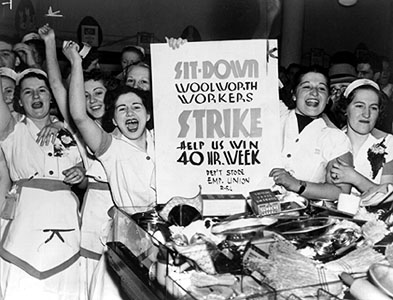From the Open-Publishing Calendar
From the Open-Publishing Newswire
Indybay Feature
General Strikes, May Day & Wildcats A History of the Strike Weapon in the U.S.

Date:
Sunday, September 26, 2010
Time:
1:00 PM
-
3:00 PM
Event Type:
Speaker
Organizer/Author:
Carl Marks
Location Details:
Niebyl-Proctor Marxist Library
6501 Telegraph Ave. (at 65th Street),
Oakland, CA 94609
510-595-7417
6501 Telegraph Ave. (at 65th Street),
Oakland, CA 94609
510-595-7417
INSANE DIALECTICAL POSSE presnets:
With the crushing of the Paris Commune in 1871, the center of the world revolutionary working class shifted westward to the militant immigrants in Gilded Age Chicago. Their “Chicago Idea” of the 1880s was agitation to create organizations to be “the living germs of a new social order which would replace the bourgeois world.” The mass movement was destroyed by the hanging of the four Haymarket Martyrs. In 1889 May Day was declared as International Workers’ Day to honor their memory (except in the U.S.).
Out of the 19th century also came the most effective tactic to unify all workers in solidarity: the general strike. The Great Railroad Strike of 1877 was the closest we have come to a nationwide general strike. In the 1919 “Seattle Commune” workers used the general strike to run the city for 5 days. During the Great Depression unemployment hit its highest rate ever (24.9% in 1933), yet the next year three general strikes (San Francisco, Minneapolis and Toledo) took the class war on the offensive. In the late 1930s the country was swept by a wave of sit-down strikes that spread like wildfire, innovating an effective new tactic. In 1946, in the strike wave that began at the end of World War II, general strikes shut down six cities (including Oakland), paralyzed whole industries, and with mass strikes everywhere, it was the most militant year in U.S. history. A wildcat strike wave occurred again in the late 1960s, led by groups like the League of Revolutionary Black Workers in Detroit.
The memory of Haymarket lives on and reappeared again with immigrants workers, this time Latina/o, in the 2006 May Day General Strike that forced the withdrawal of the racist Sensenbrenner Bill (HR 4437). This historical survey attempts to show that this radical history can serve the anti-capitalist struggles of today. This is a multimedia presentation (approximately 45 minutes); to be followed by open discussion.
This event is free. Wheelchair accessible.
With the crushing of the Paris Commune in 1871, the center of the world revolutionary working class shifted westward to the militant immigrants in Gilded Age Chicago. Their “Chicago Idea” of the 1880s was agitation to create organizations to be “the living germs of a new social order which would replace the bourgeois world.” The mass movement was destroyed by the hanging of the four Haymarket Martyrs. In 1889 May Day was declared as International Workers’ Day to honor their memory (except in the U.S.).
Out of the 19th century also came the most effective tactic to unify all workers in solidarity: the general strike. The Great Railroad Strike of 1877 was the closest we have come to a nationwide general strike. In the 1919 “Seattle Commune” workers used the general strike to run the city for 5 days. During the Great Depression unemployment hit its highest rate ever (24.9% in 1933), yet the next year three general strikes (San Francisco, Minneapolis and Toledo) took the class war on the offensive. In the late 1930s the country was swept by a wave of sit-down strikes that spread like wildfire, innovating an effective new tactic. In 1946, in the strike wave that began at the end of World War II, general strikes shut down six cities (including Oakland), paralyzed whole industries, and with mass strikes everywhere, it was the most militant year in U.S. history. A wildcat strike wave occurred again in the late 1960s, led by groups like the League of Revolutionary Black Workers in Detroit.
The memory of Haymarket lives on and reappeared again with immigrants workers, this time Latina/o, in the 2006 May Day General Strike that forced the withdrawal of the racist Sensenbrenner Bill (HR 4437). This historical survey attempts to show that this radical history can serve the anti-capitalist struggles of today. This is a multimedia presentation (approximately 45 minutes); to be followed by open discussion.
This event is free. Wheelchair accessible.
For more information:
http://FlyingPicket.org
Added to the calendar on Sat, Sep 18, 2010 2:05AM
Add Your Comments
We are 100% volunteer and depend on your participation to sustain our efforts!
Get Involved
If you'd like to help with maintaining or developing the website, contact us.
Publish
Publish your stories and upcoming events on Indybay.
Topics
More
Search Indybay's Archives
Advanced Search
►
▼
IMC Network


